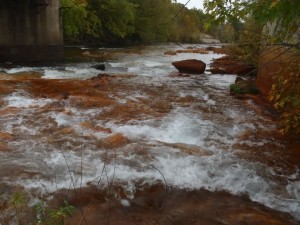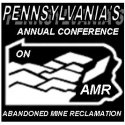Our regional non-profit environmental organization and coalition, the Eastern PA Coalition for Abandoned Mine Reclamation (EPCAMR) has been working throughout PA, with a focus on addressing abandoned mine land reclamation and abandoned mine drainage remediation since 1996. We have been supporting the cleanup of watersheds impacted by AMD and the reclamation of abandoned mine lands with a multitude of partnerships both within our region of NorthCentral and Northeastern PA’s Coalfields, as well as state-wide, complimenting the work of our sister organization, the Western PA Coalition for Abandoned Mine Reclamation (WPCAMR), that has been organized since 1982, working on the same types of abandoned mine issues in the Bituminous Coal Region of Central, NorthCentral, NorthWestern, and SouthWestern PA (www.amrclearninghouse.org). EPCAMR has both treated AMD, reclaimed abandoned mine lands, reforested abandoned mine lands, conducted outdoor environmental education programs to our underserved and underrepresented primary, secondary, and colleges and universities, coordinated 15 state-wide Conferences on abandoned mine land reclamation (www.treatminewater.com), developed public-private partnerships to address AMD remediation throughout the Coalfields of PA, and believe that we are regional leading environmental organization that is well versed in AMD remediation, abandoned mine land reclamation, and watershed restoration. Most regional legislators are familiar with our line or work.
We are urging the legislators to oppose Senate Bill 411. Our sister Coalition, may not have taken the same stance on SB 411 at this time. On behalf of our organization, we would like to bring the public’s attention to some important issues regarding this bill.
The activities that would occur as a result of the enactment of SB 411 are far-reaching and require comprehensive hydrogeological analysis and further baseline data gathering to begin to take a hard look at the future potential impacts of this piece of legislation. EPCAMR encourages the General Assembly to work to authorize the prioritization of funding to conduct further studies and detailed analyses of the potential impacts that this legislation could have on PA’s rivers, streams, and mining impacted communities that lay above the underground multi-colliery hydrologic units that are beneath our feet that we commonly call mine pool complexes. To not support such studies and further funding devoted to getting a more comprehensive understanding of the movement of the mine water underground across PA in the various AMD impacted watersheds, which does not flow in the same way water does on the surface of the land, would be a consequential mistake that should be avoided at all costs.
For the last several years, EPCAMR and our partners, including the US Geological Survey, US Department of Interior’s Office of Surface Mining Reclamation & Enforcement (OSMRE), PA DEP, Conservation Districts, the Susquehanna River Basin Commission, the Foundation for PA Watersheds, and a host of other partners have been working on developing much needed updates and hydrogeological analyses of the underground mine workings throughout the Anthracite Coal Regions of PA and have also completed work in the Bernice Mine Pool Basin, in Sullivan County, that has direct impacts to the Loyalsock Creek and its’ tributaries. EPCAMR has been updating underground mine pool water levels that had been historically monitored by the former Bureau of Mines, PA DEP, and the Federal Office of Surface Mining (OSM) during periods of active mining across the region to estimate volume estimates of underground mine water that used to need to be pumped to continue to operate underground mining operations throughout the Anthracite Region. EPCAMR is also the first organization to develop 3D regional models of mine pools for several of the Coalfields in PA. See this section of our website: https://epcamr.org/home/current-initiatives/mine-pool-mapping-initiative/ and the updated Mine Water Resources Report completed by EPCAMR. http://www.epcamr.org/storage/projects/MinePoolMapping/Mine_Water_Resources_of_the_Anthracite_Coal_Fields_-_Report.pdf
EPCAMR is currently indexing and inventorying PA DEP’s Bureau of Abandoned Mine Reclamation (BAMR) Northern Field Mine Maps, located and stored in Wilkes-Barre, PA DEP Bureau of Deep Mine Safety (DMS) Maps, located and stored in Pottsville’s District Mining Office, EPCAMR’s private collection of Mine Maps, and a limited number of the Earth Conservancy’s Glen Alden (Blue Coal Company) Mine Maps that are a private collection. EPCAMR is also in the process of scanning, digitizing, geo-referencing, and populating the PA Historic Underground Mine Map Inventory System (PHUMMIS) under a grant agreement with the PA DEP Mine Subsidence Insurance Program. See this section of our website: https://epcamr.org/home/current-initiatives/underground-mine-map-processing-for-the-pa-msi-program/
The General Assembly would be violating the Pennsylvania Constitution if it enacts SB 411 without any comprehensive environmental impact assessment. AMD does not just flow from a discharge location that has been abandoned. The underground mine pool complexes are just that, very complex, have various differential flow paths, can have flashy shallow pools, or deep, stable pools, with the potential for water storage. The impacts that the reduction of AMD could have on the land above these pools need to be taken into consideration, due to the potential for additional mine subsidence, discharges migrating to new locations, contamination of existing public water supplies, mine water being backed up and or dammed underground that could lead to upstream or adjacent flooding issues or the creation of new AMD discharges in other parts of the mining impacted watersheds.
EPCAMR is willing to provide any member of the General Assembly additional information on the work that we have been funded to perform under our grant agreements, other contract agreements, and foundation support that we’ve received over the last few years to provide them with a better understanding of the potential impacts and EPCAMR’s concern for moving forward too fast with this piece of legislation without the proper liabilities still in place for those entities that wish to withdraw mine water for other industrial purposes.
As the Pennsylvania Supreme Court made clear last month in the Act 13 litigation, the General Assembly has an obligation under Article I, Section 27 of the Pennsylvania Constitution to perform environmental impact analyses when it enacts legislation that affects the reserved environmental rights of Pennsylvania citizens and public natural resources. Performing investigation and analysis in advance of acting, and taking seriously the outcome of those analyses, is part of the General Assembly’s obligation under the Constitution to avoid infringing on each citizen’s right to a clean, healthy environment, and to act as a trustee (a fiduciary) of the people’s public natural resources.
Article I, Section 27 declares:
The people have a right to clean air, pure water, and to the preservation of the natural, scenic, historic and esthetic values of the environment. Pennsylvania’s public natural resources are the common property of all the people, including generations yet to come. As trustee of these resources, the Commonwealth shall conserve and maintain them for the benefit of all the people.
As the Supreme Court recognized, the General Assembly must “consider in advance of proceeding the environmental effect of any proposed action on the constitutionally protected features.” Robinson Twp., Washington Cnty. v. Com., — A.3d —, 2013 WL 6687290, *33 (Dec. 19, 2013) (emphasis added). Further, the General Assembly has fiduciary obligations as a trustee of public natural resources who must conserve and maintain those resources for present and future Pennsylvanians. The General Assembly must consider before acting whether the proposed legislation will lead to the “degradation, diminution, or depletion” of the people’s public natural resources either now, or in the future. Id. at *38, *40 & n.46; see also 20 Pa.C.S. § 7203(a) & (c)(5); In re Scheidmantel, 868 A.2d 464, 492 (Pa. Super. Ct. 2005) (“trustee’s action must represent an actual and honest exercise of judgment predicated on a genuine consideration of existing conditions”); 20 Pa.C.S. § 7773. The General Assembly must also consider whether the legislation places higher environmental burdens on some Pennsylvania citizens than others, which violates a trustee’s obligation to treat the beneficiaries equitably in light of the trust’s purposes. Id. at *40, *59.
SB 411 would amend the Environmental Good Samaritan Act (EGSA) and extend immunity for those involved in withdrawing abandoned mine drainage (AMD) in connection with oil and gas operations and other uses offsite. EPCAMR and WPCAMR were initially involved with assisting with providing and developing some of the language for the EGSA, when we were actively involved with the Commonwealth’s Mining and Reclamation Advisory Board (MRAB), which we both are still members of to this day. Robert Hughes, EPCAMR Executive Director is a voting member, appointed by the State Conservation Commission, representing EPCAMR, on the Board. A former Regional Coordinator for WPCAMR, Mark Killar, and were instrumental in working on the development of the language and bringing the issue of limited liability and protections for the community volunteers in PA that were taking on the treatment of AMD in their respective watersheds through their non-profit organizations that they were active members and or Conservation Districts and Conservancy groups that had taken on the challenge locally of addressing the problems associated with polluted mine water on their own, as environmental stewards of the Commonwealth, who were not responsible for creating the abandoned mine discharges.
EPCAMR would like to note that not all mine drainage is the same and not all mine drainage is acidic, in terms of acidity values pertaining to the chemistry of the mine water. This difference between abandoned mine discharges that are net acid as compared to those that are net alkaline are stark and means that the potential treatment options of that type of mine water are very different and the cost/benefit analyses are also very different when one uses AMD Treat (http://www.amd.osmre.gov/), a software package and tool created by the OSM, that the PA DEP encourages all grantees who apply for PA DEP Growing Greener funds use prior to submitting their grants to develop potential AMD treatment scenarios and their respective cost effectiveness.
EPCAMR is concerned that SB 411 would incentivize the spread of AMD-polluted water to other streams and watersheds in Pennsylvania that currently don’t have pollution problems that are related to AMD. The bill does not promote the reduction, treatment, and abatement of AMD pollution, which is the purpose of EGSA. In fact, SB 411 would harm streams and communities where the AMD water is being withdrawn, transferring water out of source watersheds, in some cases removing cold water discharges that are having minimal impacts on some watersheds and having positive biological impacts due to the temperature needed for cold water fisheries, like on the Upper Lackawanna River, where the Jermyn AMD discharge enters the Lackawanna River, and impacting water supplies upon which the people and economies rely in these areas should the mine water be removed and not augmented in some fashion.
EPCAMR interprets the Bill to read that water withdrawal companies or other industries would be granted immunity from further liability and damages that may be caused as a consequence of the withdrawal of the mine water and that they have no responsibility to treat the AMD. It doesn’t seem fair or equitable to the communities that have lived with the AMD for decades that a private entity can come in and be exempt from treating the mine water, but can profit from withdrawing it without ramifications or setting up a trust fund to treat the discharge. There is the potential for upstream and downstream damages to occur that could be hydrogeologically connected to the underground mine pool complexes that lay beneath the surface and if they are not monitored properly, the public, private homeowners, businesses, industries, and all of the Cities, towns, townships, and boroughs that are located above these areas, would not be able to be compensated for those damages, should they be correlated to the withdrawal of the mine pool water to depths that create substantial risk for future subsidence. We’re talking major population centers.
Voluminous withdrawals would deplete underground mine pool complexes and change the hydrogeology and beach levels of the AMD that could have dire consequences leading to future mine subsidence if the appropriate risk and preventative feasibility studies aren’t conducted to determine what is the safe level of withdrawal that wouldn’t cause surface impacts. EPCAMR struggles already to bring back miles of vulnerable waterways under the Environmental Good Samaritan Act (EGSA). EPCAMR does not know of any analysis to show how much of the mine water could replace fresh water that is currently being used in well drilling and hydraulic fracturing, one of the rationales the bill is based on and no industry has come forward to potentially partner with us to help to make that determination. EPCAMR is also concerned with taking untreated AMD and inserting it into the fracking process and what the future consequences of that mixture of chemicals holds for those future wells once they are depleted and the watersheds that the AMD is being transplanted to that could potentially become orphaned abandoned wells. EPCAMR is even looking for topics and research presentations on this type of concern and would encourage the industry to come to our State-wide Conference in State College, PA on June 26-27th, at the Ramada Inn Conference Center, that is in its 16th year. See www.treatminewater.com
EPCAMR conservatively estimates that there are hundreds of billions of gallons of mine water in the Anthracite Coal Fields alone just based on our current hydrogeological investigations and 3D modeling of the region. One of the reports that was prepared in collaboration for the Western Middle Anthracite Coalfields with the USGS provides details on the amount of billions of gallons of mine water lies beneath that particular area. See the following report: http://pa.water.usgs.gov/projects/groundwater/westernmiddle/.
Many of these AMD discharges are not currently being monitored for either chemistry or flow data that could lead to developing the loadings necessary to assist in determining how much of the typical trace metals (iron, aluminum, manganese, etc.) could be removed to bring the AMD to an acceptable water quality standard. This lack of monitoring is due to lack of funding and prioritization of these watersheds by the Commonwealth, although most are listed on the Federal List of Impaired Waters already. The SRBC has prepared a recent report on the larger Anthracite Region AMD discharges and developed a strategy in collaboration with EPCAMR called the Anthracite Region AMD Remediation Strategy. See the Technical Report: http://www.srbc.net/pubinfo/techdocs/Publication_279/techreport279.htm
These are some of the more substantial impacts and important inquiries and concerns that require thorough analysis before SB 411 is voted on. On behalf of EPCAMR, we are asking our Legislators who are bound to safeguard the public natural resources for our benefit and the benefit of future generations and who is bound to insure that all Pennsylvanians are treated fairly and equally, not disproportionately burdening some for the benefit of others, that you fully analyze the potential impacts of SB 411 and not move ahead without that knowledge as the Senate is now poised to do. The Supreme Court has very recently reminded the General Assembly of this obligation in Robinson Twp., Washington Cnty. v. Com, please carefully consider their ruling and recognize the relevance to SB 411.
EPCAMR remains opposed to SB 411 and we ask that SB 411 be tabled immediately so the required environmental impact assessment can be conducted, it can be referred to the Environmental Committee, and further discussion can take place to clarify, not only our concerns, but the concerns of many of our coalition partners throughout NorthCentral and NorthEastern PA, and our entire coverage area. We are going to be working with our local media outlets to start getting the word out on this important issue.













You must be logged in to post a comment.